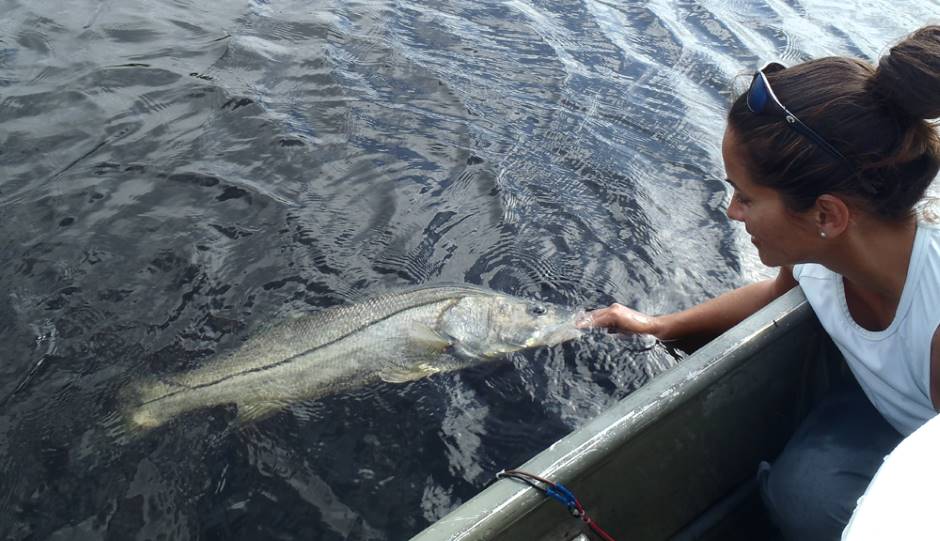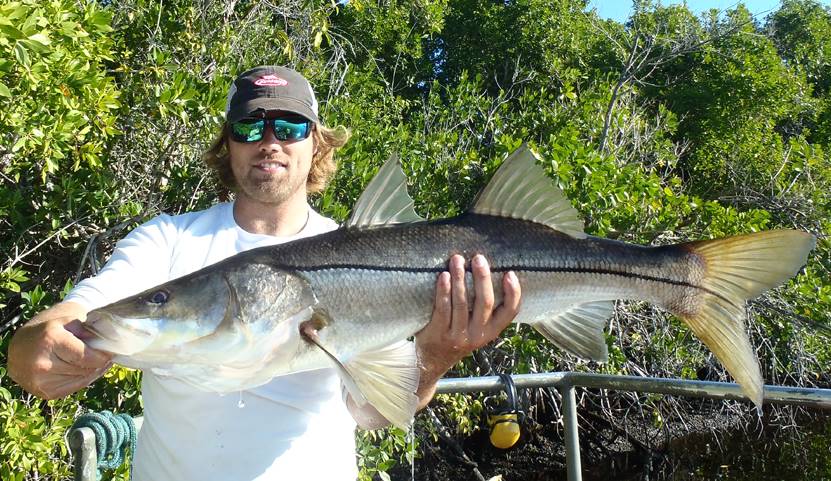Understanding Snook Production in the Everglades
 Jennifer Rehage releases a snook after it recovered from transmitter surgery. (Credit: Ross Boucek)
Jennifer Rehage releases a snook after it recovered from transmitter surgery. (Credit: Ross Boucek)Snook are a prized catch for many anglers hoping to snag the fish—however, the species also serve important ecological roles. Their popularity with anglers makes snook a valuable source of tourism in the Everglades. Prized for their fighting abilities and good taste, many anglers in the Everglades start their trip with the intention of catching snook specifically.
The fish are a staple in the area’s tourism industry and essential to protecting the local economy. At the same time, snook help maintain the balance of the Everglades ecosystem as a native predator species. Beyond anglers, many tourists travel to the Everglades each year to view the wetland environment. Snook are part of this delicate system, and the loss of the species could have cascading effects on the rest of the system.
Risks to Snook Populations
Unfortunately, snook production from year to year can be difficult to predict. Like other species, snook populations are subject to natural variability as a result of predation, low recruitment, competition and disease. Similarly, snook are sensitive to environmental changes. For example, variances in water quality, like temperature, salinity and dissolved oxygen levels, can have dramatic impacts on the species’ health.
The tropical fish, like others, evolved to spawn in conditions that are fairly constant. But since there are seasonal changes in Everglades’ rainfall, they’ve developed strategies to compensate for the variability. When it’s time to spawn, Florida snook migrate to coastal wetlands where their eggs will be carried by high current flows. As a result, production rates are particularly vulnerable to precipitation variances.
Due to the fish’s popularity with anglers, the species may also be subjected to fishing pressure. The fish are popular due to their status as a challenging catch as well as for their flavor. As a result, many snook caught in the Everglades are not released but are instead kept and eaten.
In order to avoid this from happening in large quantities, the Florida Fish and Wildlife Conservation Commission regulates snook fishing. As of 2023, snook fishing is restricted to recreational anglers exclusively, with season closures occurring from Dec. 1 to the end of February and May 1 to Aug. 31. In order to ensure the species have a chance to spawn, there are size limits and daily bag limits that ensure the species are not overfished.
There is the added problem of knowledge surrounding snook production being limited. These knowledge gaps are, in part, attributed to environmental challenges, declines in the population that may make it difficult to study snook in the quantity necessary, and an overall lack of attention on the fishing research settings has led to limited understandings today. However, researchers at Florida International University are looking to change that.
Studying Snook Production
“It’s a really interesting fish,” said Ross Boucek, a doctoral graduate from the Department of Biological Sciences at FIU and leader of a research project backed by the Everglades Foundation. “They’re very fast runners and they’re hard to fool. They grow to a big size, but their downfall is that they taste good.”
Based on the variations in production as a result of increased precipitation in the Everglades, it is clear there is an important relationship between successful snook spawning and water flows, but scientists can’t yet describe exactly what the relationship is. “In terms of population dynamics and reproductive biology, it’s one of the most well-known fish, but there’s still not a lot known,” said Boucek.
Looking at where and when snook spawn may help provide insight into their reproductive efforts, says Boucek. He hypothesizes that higher seasonal rainfalls yield better flows and spawning for snook. He tested the idea by combining rainfall data gathered from several local sources with tracking data from transmitters implanted in fish. The results of the study can be found here.
“With snook being a harvested fish, we lose about 50 percent (of those tagged) each year to fishing or natural mortality,” said Boucek.
Snook generally spawn in the region from May through November each year, but actually knowing when they migrate provides a much more precise time frame for when they’re spawning, Boucek says.
“The ultimate goal is to use spawning rates and relate them to angler catch records,” said Boucek. He’s getting them from local partners like Southernmost Bass Anglers and the Gene Doyle Fishing Tournament. “If we can pinpoint these wet season years, we can predict good and bad fishing years. Then we can make that data available to fishing guides and tour guides.”
Conclusion
The results of the study ultimately revealed that high river water levels and flow serve as one of the primary cues triggering migration timing. The research as a whole will help inform the implementation of the Comprehensive Everglades Restoration Plan, which will likely have impacts on many economically important fish in the region.
Assessing where and when snook spawn, it’s possible to gain a better sense of their reproductive efforts, says Boucek, and he has a hypothesis that higher seasonal rainfalls yield better flows and spawning. He’s testing the idea by combining rainfall data gathered from several local sources with tracking data from transmitters implanted in snook.
“With snook being a harvested fish, we lose about 50 percent (of those tagged) each year to fishing or natural mortality,” said Boucek.
Snook generally spawn in the region from May through November each year, but actually knowing when they migrate provides a much more precise time frame for when they’re spawning, Boucek says.



0 comments